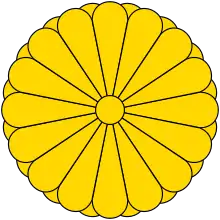Hakkō ichiu
Hakkō ichiu (八紘一宇, "eight crown cords, one roof" i.e. "all the world under one roof") or Hakkō iu (八紘爲宇, Shinjitai: 八紘為宇) was a Japanese political slogan meaning the divine right of the Empire of Japan to "unify the eight corners of the world". This slogan formed the basis of the Japanese Empire's ideology. It was prominent from the Second Sino-Japanese War to World War II, popularized in a speech by Prime Minister Fumimaro Konoe on January 8, 1940.[1]
| Hakkō ichiu | |||||
|---|---|---|---|---|---|
| Japanese name | |||||
| Kanji | 八紘一宇 | ||||
| Kana | はっこういちう | ||||
| |||||
| Hakkō ichiu | |||||
|---|---|---|---|---|---|
| Japanese name | |||||
| Kana | はっこういう | ||||
| Kyūjitai | 八紘爲宇 | ||||
| Shinjitai | 八紘為宇 | ||||
| |||||
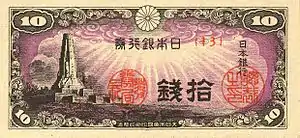
Concept
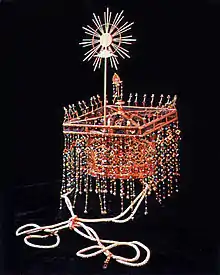
The term was coined early in the 20th century by Nichiren Buddhist activist and nationalist Tanaka Chigaku, who cobbled it from parts of a statement attributed in the chronicle Nihon Shoki to legendary first Emperor Jimmu at the time of his ascension.[2] The Emperor's full statement reads: "Hakkō wo ooute ie to nasan" (八紘を掩うて宇と為さん, or in the original kanbun: 掩八紘而爲宇), and means: "I shall cover the eight directions and make them my abode". The term hakkō (八紘), meaning "eight crown cords" ("crown cords" being the hanging decorations of the benkan (冕冠), a traditional Chinese-styled crown), was a metaphor for happō (八方) or "eight directions".[3]
Ambiguous in its original context, Tanaka interpreted the statement attributed to Jinmu, as meaning that imperial rule had been divinely ordained to expand until it united the entire world. While Tanaka saw this outcome as resulting from the emperor's moral leadership, many of his followers were less pacifist in their outlook, despite some intellectuals' awareness of the inherent nationalist implications and reactions to this term. Koyama Iwao (1905–93), disciple of Nishida, and drawing off the Flower Adornment Sutra, proposed the interpretation "to be included or to find a place". This understanding was rejected by the military circles of the nationalist right.[4][5]
Racial equality and growing expansionism
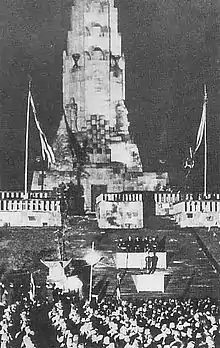


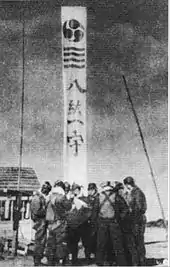
There were enough Japanese in Western nations that suffered from racial discrimination issues that In 1919 Japan proposed a racial equality clause at the Paris Peace Conference. Their proposal received the support of a majority but was vetoed by Woodrow Wilson, in violation of the rules of the Conference on majority vote. In 1924, the U.S. Congress enacted the Asian Exclusion Act, outlawing immigration from Asia. On December 6, 1938, the Five ministers council (Prime Minister Fumimaro Konoe, Army Minister Seishirō Itagaki, Navy Minister Mitsumasa Yonai, Foreign Minister Hachirō Arita and Finance Minister Shigeaki Ikeda), which was the highest decision making council at the time,[7][8] took the decision to prohibit the expulsion of the Jews from Japan, Manchuria, and China in accordance with the spirit of racial equality.[7][8] Thereafter, the Japanese received Jewish refugees despite their ally Nazi Germany's opposition.
With the economic impact of the Shōwa financial crisis and the Great Depression, this led in the 1930s to a resurgence of nationalist, militarist and expansionist movements. Emperor Shōwa (known more commonly as Hirohito outside of Japan) and his reign became associated with the rediscovery of Hakkō ichiu as an expansionist element of Japanese nationalistic beliefs.[9] The naval limitations treaties of 1921, and especially 1930, were seen as a mistake in their unanticipated effect on internal political struggles in Japan; and the treaties provided an external motivating catalyst which provoked reactionary, militarist elements to desperate actions which eventually overwhelmed civilian and liberal elements in society.[10]
The evolution of Hakkō ichiu serves as a changing litmus test of these factional relationships during the next decade.[11]
The term Hakkō ichiu did not enter general circulation until 1940, when the second Konoe administration issued a white paper titled "Fundamental National Policy" (基本国策要綱 Kihon Kokusaku Yōkō), which opened with these words, and in which Prime Minister Konoe proclaimed that the basic aim of Japan's national policy was "the establishment of world peace in conformity with the very spirit in which our nation was founded"[12] and that the first step was the proclamation of a "new order in East Asia" (東亜新秩序 Tōa Shin Chitsujo), which later took the form of the "Greater East Asia Co-Prosperity Sphere".[13] In the most magnanimous form, the term was used to indicate the making of a universal brotherhood implemented by the uniquely virtuous Yamato.[14] Because this would bring people under the emperor's fatherly benevolence, force was justified against those who resisted.[15]
1940 was declared the 2600th anniversary of the founding of Japan in part in celebration of hakkō ichiu.[16] As part of the celebrations, the government officially opened the Hakko-ichiu Monument (now Heiwadai Tower) at what is now Miyazaki Peace Park in the city of Miyazaki.
World War II
As the Second Sino-Japanese War dragged on without conclusion, the Japanese government turned increasingly to the nation's spiritual capital to maintain fighting spirit.
Characterization of the fighting as a "holy war" (聖戦, seisen), similarly grounding the current conflict in the nation's sacred beginnings, became increasingly evident in the Japanese press at this time. In 1940, the Imperial Rule Assistance Association was launched to provide political support to Japan's war in China.
The general spread of the term Hakkō ichiu, neatly encapsulating this view of expansion as mandated in Japan's divine origin, was further propelled by preparations for celebrating the 2600th anniversary of Jimmu's ascension, which fell in the year 1940 according to the traditional chronology. Stories recounted that Jimmu, finding five races in Japan, had made them all as "brothers of one family".[17]
Propaganda purposes
After Japan declared war on the Allies in December 1941, Allied governments produced several propaganda films citing the Hakkō ichiu as evidence that the Japanese intended to conquer the entire world.
As part of its war effort, Japanese propaganda included phrases such as "Asia for the Asians!" and emphasized about the perceived need to liberate Asian countries from imperialist powers.[18] The failure to win the war in China was blamed on British and American exploitation of Southeast Asian colonies, even though the Chinese received far more assistance from the Soviet Union.[19] In some cases local populations welcomed Japanese troops when they invaded, driving out British, French and other colonial powers.[18]
The official translation offered by contemporary leaders was "universal brotherhood", but it was widely acknowledged that that expression meant that the Japanese were "equal to the Caucasians but, to the peoples of Asia, we act as their leader".[20] Hence Hakkō ichiu meant to signify racial harmony and equality. In general, however, the subsequent brutality and racism of the Japanese led to people of the occupied areas regarding the new Japanese imperialists as equal to or sometimes worse than Western imperialists.[18] The Japanese government directed that local economies be managed strictly for the production of raw war materials for the Japanese.[21]
Allied judgment
Hakkō Ichiu meant the bringing together of the corners of the world under one ruler, or the making of the world one family.[22] This was the alleged ideal of the foundation of the Empire; and in its traditional context meant no more than a universal principle of humanity, which was destined ultimately to pervade the whole universe.[22] The way to the realisation of Hakkō Ichiu was through the benign rule of the Emperor; and therefore the "way of the Emperor"—the "Imperial" or the "Kingly way"—was a concept of virtue, and a maxim of conduct.[22] Hakkō Ichiu was the moral goal; and loyalty to the Emperor was the road which led to it.[22] Throughout the years that followed measures of military aggression were advocated in the names of Hakkō ichiu eventually became symbols for world domination through military force.[22]
Aftermath
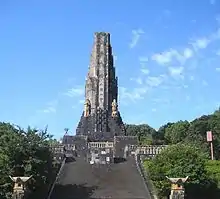
Since the end of the Pacific War, some have highlighted the Hakkō ichiu slogan as part of a context of historical revisionism.[23] The Hakkō ichiu monument was renamed Heiwa no tou (Tower of Peace) (平和の塔) in 1958 and still stands today. The writing "Hakkō ichiu" was removed from it after the Japanese defeat at the insistence of the U.S. military.[24] The tower was the inception point for the torch relay of the 1964 Summer Olympics.[24] Subsequent to the Olympics, which coincided with worldwide interest in the Japanese Imperial family, the local tourism association successfully petitioned the Miyazaki Prefecture to re-install the "Hakkō ichiu" characters.[24]
See also
Notes
- Beasley, Japanese Imperialism 1894–1945, pp. 226–7.
- As early as 1928, the Japanese editorials were already preaching the theme of the hakko ichiu without using the specific term. Michio Nakajima, Tennō no daigawari to kokumin, Aoki Shoten 1990, pp. 129–30.
- Jitō 字統,Shirakawa Shizuka, Heibonsha, 1994, p. 302, 紘 entry. The kun-reading ie for on-reading u 宇 is now defunct, but at the time of the Nihon Shoki, readings were not yet fixed in the way that was later to become the case. Rather, any meaning associated with a Chinese character as used in Chinese was, in theory, available as a reading as evidenced by the sometimes extreme variation in the writing of even common words in the Nihon Shoki.
- Jonckheere, Fabrice (2011). "Hakko ichiu theory (八 纮 一 宇)". Pacific War: the initial expansion. History of the last war no. 15. Caraktere ed. p. 62. ISSN 2104-807X. Archived from the original on November 11, 2013.
- See also Kosei Ishii
- David C. Earhart, Certain Victory, 2008, p. 63.
- "Question 戦前の日本における対ユダヤ人政策の基本をなしたと言われる「ユダヤ人対策要綱」に関する史料はありますか。また、同要綱に関する説明文はありますか。". Ministry of Foreign Affairs of Japan. Retrieved September 21, 2010.
- "猶太人対策要綱". Five ministers council. Japan Center for Asian Historical Record. December 6, 1938. p. 36/42. Archived from the original on July 26, 2011. Retrieved September 21, 2010.
- Bix, Herbert. (2001). Hirohito and the Making of Modern Japan, p. 201.
- Morison, Samuel Eliot. (1948). History of United States Naval Operations in World War II: The Battle of the Atlantic, September 1939 – May 1943, pp. 3–10.
- John Pike, (2011). "Kodo (Way of the Emperor)". GlobalSecurity.org
- Edwards, p. 309.
In the original text, 「肇国の大精神に基き世界平和の確立を招来すること」 - James L. McClain, Japan: A Modern History p 470 ISBN 0-393-04156-5
- Piers Brendon, The Dark Valley: A Panorama of the 1930s, p43 ISBN 0-375-40881-9
- Herbert P. Bix, Hirohito and the Making of Modern Japan p 11 ISBN 0-06-019314-X
- Edwin P. Hoyt, Japan's War, p 196 ISBN 0-07-030612-5
- John W. Dower, War Without Mercy: Race & Power in the Pacific War p223 ISBN 0-394-50030-X
- Anthony Rhodes, Propaganda: The Art of Persuasion: World War II, p248 1976, Chelsea House Publishers, New York
- James L. McClain, Japan: A Modern History p 471 ISBN 0-393-04156-5
- Stephen S. Large. Shōwa Japan. New York: Taylor & Francis, 1998. p. 202.
- James L. McClain, Japan: A Modern History p 495 ISBN 0-393-04156-5
- Clancey, Patrick. "Chapter IV: The Military Domination of Japan and Preparations for War". HyperWar: International Military Tribunal for the Far East.
- Goodman, David G. "Visas and Virtue by Chris Tashima" [review], Journal of Japanese Studies, Vol. 26, No. 1 (Winter, 2000), pp. 266–269; excerpt, "Japanese historical revisionists, however, assert that Sugihara was not in fact a renegade but an exemplary diplomat who ... dutifully carrying out the high-minded Japanese policy of racial harmony under the aegis of the emperor (hakko ichiu)"
- Motomura, Hiroshi (February 10, 2015). "Miyazaki's controversial Peace Tower continues to cause unease". Japan Times. Retrieved March 21, 2018.
References
- Beasley, William G. (1991). Japanese Imperialism 1894–1945. Oxford: Oxford University. ISBN 978-0-19-822168-5.
- Bix, Herbert P. (2001). Hirohito and the Making of Modern Japan. New York: HarperCollins. ISBN 978-0-06-093130-8.
- Brendon, Piers (2002). The Dark Valley: A Panorama of the 1930s. New York: Vintage. ISBN 978-0-375-70808-4.
- Brownlee, John (1997). Japanese Historians and the National Myths, 1600–1945: The Age of the Gods. Vancouver: University of British Columbia Press. ISBN 0-7748-0645-1.
- Earhart, David C. (2007). Certain Victory: Images of World War II in the Japanese Media. Armonk, New York: M.E. Sharpe. ISBN 978-0-7656-1776-7.
- Edwards, Walter. "Forging Tradition for a Holy War: The Hakkō Ichiu Tower in Miyazaki and Japanese Wartime Ideology." Journal of Japanese Studies 29:2 (2003).
- Morison, Samuel Eliot (1948). History of United States Naval Operations in World War II: The Battle of the Atlantic, September 1939 – May 1943. Oxford: Oxford University Press. 40 editions – [reprinted by University of Illinois Press at Urbana, 2001. ISBN 978-0-252-06973-4].
- Kosei, Ishii (2002). The idea of "co-prosperity Sphere of Greater East Asia" and the Buddhist philosophy - the role of the School of Kyoto. Paris: Inalco. ISBN 2-85831-105-6.
External links
| Look up hakkō ichiu in Wiktionary, the free dictionary. |
